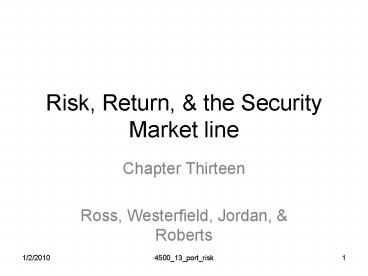Risk, Return, PowerPoint PPT Presentation
1 / 33
Title: Risk, Return,
1
Risk, Return, the Security Market line
- Chapter Thirteen
- Ross, Westerfield, Jordan, Roberts
2
Risk Return unequal probabilities
- Expected return
- Standard deviation
- Covariance
3
An example
4
Statistics - Risky, Ltd.
5
Statistics - Sleepy Time Ltd.
6
Relevant measure of risk Covariance
7
Covariance matrix
- RR 0.228, SDR 0.2418
- RST 0.102, SDST 0.0987
- RM 0.128, SDM 0.156
8
Correlation
- Correlation normalizes covariance
- value of 1 means perfect positive correlation
- value of 0 means independence between data series
- value of -1 means perfect negative correlation
9
Diversification
- Correlation is a measure of how two assets react
together to economic market conditions - High positive correlation
- Two assets are affected similarly by economic
events - High negative correlation
- Two assets are affected in completely opposite
ways by economic events - Independence -zero correlation
- Two assets are act independent of each other
relative to economic events
10
Correlation matrix
11
Portfolio Statistics
Expected return to the portfolio of multiple
assets
Standard deviation to a portfolio of multiple
assets
12
Portfolio expected return, two assets different
proportions
13
Portfolio standard deviation
14
Portfolio Risk
15
Two-asset Portfolio
Preferred Portfolio
Ep
Efficient Set
Opportunity Set
Risk preferences
SDP
16
Implications of Correlation Statistics
- The lower the pair-wise correlation of two
assets, the greater the diversification benefit
of adding those assets to your portfolio - Adding assets which have low pair-wise
correlation with each other to your portfolio
reduces overall portfolio risk
17
Affects of Correlation
Ep
High Correlation
Low Correlation
SDP
18
Three-asset Portfolio
Ep
SDP
19
Calculating Portfolio values - three asset
portfolio
20
Multiple-asset Portfolio
Ep
SDP
21
Systematic Risk
SDp
SDM
N
22
Systematic Risk
- As you diversify your portfolio by adding assets,
your portfolio standard deviation decreases - Optimal approx 20 assets 21.68
- 2010020 40,000 buying individual stocks
- Buy funds which are already diversified
- When you are fully diversified, your risk is the
risk of the market portfolio - By changing portfolio proportions you can modify
risk to suit your preferences
23
Optimal Portfolio
U2
U1
Capital Market Line
Less risk averse
EM
More risk averse
SDM
24
Relevant statistic for a fully diversified
portfolio - Beta
- Beta measures only the systematic risk of an
assets - Beta is also a covariance but normalized the
market variance
25
The Risk-free Asset
- The risk-free asset does not exist except as a
theoretical concept - One less-risky asset is the T-bill
- Low default risk - government backing
- Low interest rate risk - very short-term
security - One month 4.22 (unusual)
- Least risky Bank of Canada bank rate
- 4.75
26
Capital Asset Pricing Model
- Prices the risk of asset relative to its
systematic risk - gives the required rate of return relative to its
systematic risk
27
Security Market Line
rM
1
28
Security Market Line - Change in rate of
inflation
rM
rM
Inflation adjustment
1
29
Security Market Line -Change in Risk Premium
rM
rM
Slope change reflecting increased Systematic Risk
1
30
Own Statistics for five assets
- Expected returns and standard deviations for some
securities
31
Pairwise Covariance
- Covariance Matrix
32
Questions
- How do you determine the best two assets to
include into your portfolio - What is the covariance of the risk free asset
with any other asset - Calculate some statistics for portfolios of two,
three, and four assets - plot an efficient set for assets for assets two
and five
33
Questions cont
- Does the required rate of return equal the
expected return on all assets - What happens if they are not equal?

